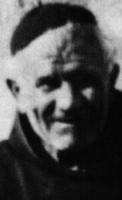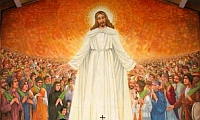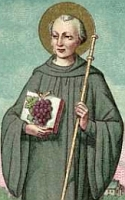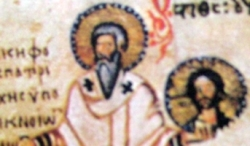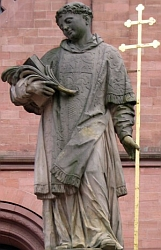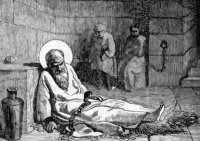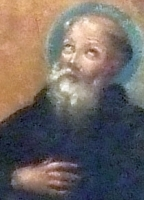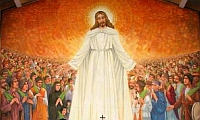Saint Kevin of Glendalough
Also known as
• Kevin of Glen da locha
• Caoimhghin, Coemgen, Coemgenus, Comegen, Keivin
Profile
Son of Coemlog and Coemell, Leinster nobility. Baptized by Saint Cronan of Roscrea, and educated by Saint Petroc of Cornwall from age seven. Lived with monks from age 12. Studied for the priesthood in Cell na Manach (Killnamanagh). Student of Saint Eonagh. Priest, ordained by bishop Lugidus. Monk. Acquaintance of Saint Comgall, Saint Columba, Saint Cannich, and Saint Kieran of Clonmacnois.
Following his ordination, he lived as a hermit for seven years into a cave at Glendalough, a Bronze Age tomb now known as Saint Kevin's Bed, to which he was reportedly led by an angel. He wore skins, ate the nettles and herbs that came to hand, and spent his time in prayer. Word of his holiness spread, and he attracted followers, including Saint Moling. Founded the monastery at Glendalough, which included relics brought back during a pilgrimage to Rome, Italy. This house, in turn, founded several others, and around it grew a town which became a see city, though now subsumed into the archdiocese of Dublin. Served as abbot for several years. When he saw that the monastery was well-established, he withdrew to live as a hermit. Four years later, however, he returned to Glendalough at the entreaty of his monk, and served as abbot until his death at age 120. King Colman of Ui Faelain entrusted Kevin with raising his son.
Noted as a man who did not always like the company of men - but was at home with the animals, as some of the legends surrounding him show.
During a drought, Kevin fed his monks with salmon, a symbol of wisdom, brought to him by an otter. When one of the monks considered making gloves out of the otter's pelt, it left and never returned.
Once during Lent, while he held his arms outstretched in prayer, a blackbird laid an egg in the Kevin's hand. He remained in that position until the baby bird hatched.
A cow which habitually licked Kevin's clothes while the saint was in prayer gave as much milk as 50 other cows.
Lacking milk to feed the son of King Colman, Kevin prayed for help. A doe arrived to provide for the baby. When the doe was later killed by a wolf, Kevin chastised the killer; the wolf then provided the milk herself.
A young man with severe epilepsy received a vision that he would be cured by eating an apple. There were, however, no apple trees about. Kevin, seeing the lad's need, ordered a willow to produce apples; twenty yellow apples appeared on the tree.
In his old age, King O'Tool of Glendalough made a pet of a goose. As time passed, the goose also became aged and weak, and finally unable to fly. Hearing of Kevin's sanctity and power, the pagan king sent for him, and asked that he make the beloved goose young. Kevin asked for a payment of whatever land the goose would fly over. As the goose could no longer take flight, O'Toole agreed. When Kevin touched the bird, it grew young, and flew over the entire valley that was used to found the monastery of Glendalough.
A boar was being chased by a group of hunters with their dogs. It ran to where Kevin sat praying under a tree, and cowered beside him for protection. When the dogs saw the saint in prayer, they laid on their stomachs, and would not approach the boar. When the hunters decided they would ignore the man and kill the boar, a flock of birds settled in the tree above the praying saint. The hunters took this as a sign, and left man and beast alone.
Born
c.498 at the Fort of the White Fountain, Leinster, Ireland
Died
3 June 618 of natural causes
Canonized
1903 (cultus confirmed)
Patronage
• blackbirds
• Ireland
• archdiocese of Dublin, Ireland
• Glendalough, Ireland
Martyrs of Uganda
புனித சார்லஸ் லுவாங்கா
( St. Charles Lwanga )
மறைசாட்சி/ ஆப்ரிக்க இளைஞர்களின் பாதுகாவலர் :
பிறப்பு :1860 அல்லது 1865
உகாண்டா, ஆப்ரிக்கா
இறப்பு : ஜூன் 3, 1886
ஆப்ரிக்கா
முத்திபேறு பட்டம்: 1920
திருத்தந்தை பதினைந்தாம் பெனடிக்ட்
புனிதர் பட்டம்: 18 அக்டோபர் 1964
திருத்தந்தை ஆறாம் பவுல்
நினைவுத் திருநாள் : ஜுன் 3
"வெள்ளைக் குருக்கள்" என்றழைக்கப்படும் துறவற சபையினர் ஆப்ரிக்காவில் நைல் நதி மேற்குப்பகுதியில் வாழ்ந்து வந்து மக்களிடையே 1878ல் மறைபரப்புப்பணியில் இறங்கினர். 1879ம் ஆண்டு பெரிய சனிக்கிழமையன்று முதன்முதலாக சிலர் திருமுழுக்கு பெற்றனர். இவர்களில் சிலர் இஸ்லாம் மறையிலிருந்து புரோட்டஸ்டாண்டு சபைக்கு மாறி, அதிலிருந்து கத்தோலிக்கரானவர்கள்.
கத்தோலிக்க மெய்மறை மிக விரைவாக பரவுகிறதென்பதை உணர்ந்த இஸ்லாமியரின் தூண்டுதலால் 1886ல் முவாஷ்கா (Muwashka) என்ற அரசன் கத்தோலிக்கர்களைத் துன்புறுத்த ஏவிவிட்டான்.
சார்லஸ் லுவாங்காவும் அவரின் தோழர்களும் அரச அவையில் பணிபுரிந்து வந்தனர். இவர்கள் எல்லாரும் 13-30 வயதுக்குட்பட்ட இளைஞர்கள். முவாஷ்கா ஓரின சேர்க்கைக்கு அடிமைப்பட்டவனாக இருந்தான். அவன் அரச அலுவல் புரிந்தவர்களைக் கெடுக்க சூழ்ச்சி செய்தபோது, சார்லஸ் தம் தோழர்களிடம், "இது தீமையானது, கொடுமையானது" என்று அறிவுரை கூறி ஓரின சேர்க்கையில் ஈடுபடாமல் காப்பாற்றி வந்தார். சார்லஸ் தான் புதிதாக பெற்றுக்கொண்ட விசுவாசத்திற்காக நமுகொஸ்கோ (Namukosco) என்ற இடத்தில் நெருப்பிலிடப்பட்டு கொல்லப்பட்டார்.
சார்லஸின் அறிவுரைப்படி மற்ற இளைஞர்கள் தங்கள் புனிதத்தில் நிலைத்து நின்றனர். 13 வயதான சிறு பெண் தனது கற்புக்காக மற்றவர்களைப்போல உயிரைத் தியாகம் செய்தார். இந்த வேதகலாபனை முடிந்த மறு ஆண்டிலேயே ஆப்பிரிக்காவின் இந்தப் பகுதியில் மறைபரப்பு பணி மிக விரைவாக பரவியது. ஆப்பிரிக்காவில் இந்த மறைசாட்சிகளின் இரத்தம் சிந்தப்பட்டதன் பயனாக ஒரு புதுயுகம் தோன்றிவிட்டது. முழுமையான சுதந்திரம் பெற்று மகிழும் ஆப்பிரிக்காவாக பொலிவுடன் வளர்ந்து கொண்டிருக்கிறது. இவர்களின் வேதனையில் புதிய யுகத்தை சார்ந்த ஆப்பிரிக்கா மக்களின் ஆன்மீக மேம்பாட்டுக்கான பாடங்கள் பல மிளிர்கின்றன.
மறைசாட்சிகள் தூண்களில் கட்டப்பட்டனர். சிறையில் அடைக்கப்பட்டனர். சாட்டையடி பட்டனர். ஈட்டிகளால் குத்தப்பட்டனர், சுட்டெரிக்கப்பட்டனர். தலை வெட்டப்பட்டனர். இப்படி இருந்தும் ஆப்பிரிக்காவில் கிறிஸ்தவர்கள் பலுகிப் பெருகினர்.
A group of courtiers and servants who died with St. Charles Lwanga in the court of King Mwanga of Uganda. Some martyrs were young boys. They were slain with horrible cruelty. All were converts of the White Fathers founded by Charles Cardinal Lavigerie in 1868. A shrine, now a basilica, was erected in their honor. They were canonized in 1964.
For the university, see Uganda Martyrs University.
The Uganda Martyrs are a group of 23 Anglican and 22 Catholic converts to Christianity in the historical kingdom of Buganda, now part of Uganda, who were executed between 31 January 1885 and 27 January 1887.[2][3]
They were killed on orders of Mwanga II, the Kabaka (King) of Buganda. The deaths took place at a time when there was a three-way religious struggle for political influence at the Buganda royal court. The episode also occurred against the backdrop of the "Scramble for Africa" – the invasion, occupation, division, colonization and annexation of African territory by European powers.[4] A few years after, the English Church Missionary Society used the deaths to enlist wider public support for the British acquisition of Uganda for the Empire.[5] The Catholic Church beatified the 22 Catholic martyrs of its faith in 1920 and canonized them in 1964.
List of the Catholic martyrs
Achilleus Kiwanuka (d. 3 June 1886)
Adolphus Ludigo-Mukasa (d. 3 June 1886)
Ambrosius Kibuuka (d. 3 June 1886)
Anatoli Kiriggwajjo (d. 3 June 1886)
Andrew Kaggwa (d. 26 May 1886)
Antanansio Bazzekuketta (d. 27 May 1886)
Bruno Sserunkuuma (d. 3 June 1886)
Charles Lwanga (d. 3 June 1886)
Denis Ssebuggwawo Wasswa (d. 25 May 1886)
Gonzaga Gonza (d. 27 May 1886)
Gyavira Musoke (d. 3 June 1886)
James Buuzaabalyaawo (d. 3 June 1886)
John Maria Muzeeyi (d. 27 January 1887)
Joseph Mukasa (d. 15 November 1885)
Kizito (d. 3 June 1886)
Lukka Baanabakintu (d. 3 June 1886)
Matiya Mulumba (d. 30 May 1886)
Mbaga Tuzinde (d. 3 June 1886)
Mugagga Lubowa (d. 3 June 1886)
Mukasa Kiriwawanvu (d. 3 June 1886)
Nowa Mawaggali (d. 31 May 1886)
Ponsiano Ngondwe (d. 26 May 1886)
Two martyrs of Paimol
There were also two Ugandan martyrs of a later period, who died at Paimol in 1918 and were beatified in 2002.[42] These have not yet been canonized.
The martyrs Daudi Okelo and Jildo Irwa were two young catechists from Uganda. They belonged to the Acholi tribe, a subdivision of the large Luo group. They lived and were martyred in the years immediately following the founding of the mission of Kitgum by the Comboni Missionaries in 1915.
Anglicanism
The Martyrs of Uganda are remembered in the Church of England with a commemoration on 3 June,[44] when commemorating the martyrs of Uganda, the Church of England includes Archbishop Janani Luwum, who was murdered in 1977 by Idi Amin's henchmen; they also commemorate Luwum separately on 16 February.
List of the Anglican Protestant martyrs
Makko Kakumba
Yusuf Lugalama
Nuwa Sserwanga
Mukasa Musa
Eriya Mbwa
Muddu Aguma
Daudi Muwanga
Muwanga
Kayizzi Kibuuka
Mayanja Kitogo
Noah Walukaga
Alexander Kdoko
Fredrick Kizza
Robert Munyangabyanjo
Daniel Nakabandwa
Kiwanuka Gyaza
Mukasa Lwakisiga
Lwanga
Mubi
Wasswa
Kwabafu
Kifamunnyanja
Muwanga Njigiya
Canonized
18 October 1964 by Pope Paul VI at Rome, Italy
Patronage
archdiocese of Accra, Ghana
Saint John Grande
Also known as
• John the Great Sinner
• Juan Grande Pecador
• Juan Grande Román
• Juan Grande
• Juan Pecador
Profile
Raised in a solidly Christian family, John was a choir boy from age 7 to 12. He was apprenticed in the linen business in Seville, Spain from age 15, and then returned to Carmona, Spain to start his own shop. At age 19 he left business behind, gave away his possessions, and became a hermit at Marcena. Referred to himself not just as Juan Grande, his given name, but Juan Grande Pecador (John the Great Sinner).
Worked in prisons and hospitals in Jerez de la Frontera, Spain. With the aid of a wealthy couple in the area, he founded and managed the Hospital de Nuestra Señora de la Candelaria (Our Lady of Candlemas) at Jerez. He affiliated the place with the Order of Hospitallers, handing it over to Saint John of God, and joining the Order himself at Granada, Spain in 1574. During an outbreak of the plague in 1574, he organized a group to help tend to victims; they were very successful. At the request of the Archbishop of Seville, Spain he completely reformed the Church's health care system in the diocese, improving efficiency and services.
John was blessed with mystical gifts, and predicted the fall of the Spanish Armada. He ran afoul of many in authority, chastising officials and those who ran charities when they lived well, and those they were supposed to serve continued to suffer. Arranged anonymous dowries for poor girls so they could marry and avoid lives on the street. He fed and clothed prisoners and refugees, and died tending to plague victims.
Born
6 March 1546 at Carmona, Andalusia, Spain
Died
• 3 June 1600 at Jerez, Spain of plague
• relics at the diocesan Shrine of Saint John Grande, Saint John Grande Hospital, Jerez
Canonized
2 June 1996 by Pope John Paul II
Patronage
diocese of Jerez de la Frontera, Spain
Blessed Adam of Guglionesi
Also known as
• Adam the Abbot
• Adamo, Adão
Additional Memorial
2nd Sunday in October (return of stolen relics)
Profile
Benedictine monk. Abbot of the monastery of Santa Maria to the Italian Tremiti Islands. Attended the council of Melfi on 21 August 1059. Worked to unify the people of southern Italy as a way reduce into-city warring. Retired in 1071 to spend his remaining months as a prayerful hermit at the monastery of Saint Paul in Petacciato, Italy.
Born
c.990 in Petazio (modern Petacciato), Italy
Died
• 1072 in the Saint Paul monastery in Petacciato, Italy of natural causes
• Archpriest Benedict of Guglionesi, Italy had a dream of an angel who told him to bring Abbot Adam’s relics to Guglionesi
• relics taken to Gulionesi on 2 June 1102; legend says that the oxen pulling the transport cart became thirsty, pawed the road with one hoof, and springs erupted from the ground
• relics enshrined on 3 June 1102 in Guglionesi
• relics re-enshrined in a gilded bronze bust reliquary in 1153
• reliquary stolen by French supporters of King Charles VIII on the night of the feast of Corpus Christi in 1496 and taken to Campobasso, Italy where they planned to melt it for the prescious metal; the presence of relics made them hesitate, and the city was beseiged by storms until they returned the reliquary to Guglionesi
• reliquary was one of several stolen on the night of 2 June 1885
• relics returned in 1886 re-enshrined in a silver bust
• relics enshrined in the church of Santa Maria Maggiore in Guglionesi
Patronage
Guglionesi, Italy
Saint Clotilde
Also known as
Chlodechildis, Chrodechildis, Clothilde, Clotichilda, Clotild, Clotilda, Croctild, Crotildes, Hlodihildi, Hlotild, HroÞihildi, Rotilde
Profile
Born a princess, the daughter of King Chilperic of Burgundy. Married young to King Clovis of the Salian Franks while he was still a pagan; she brought him to the faith. Queen. Mother of three sons. Led her husband to Christianity in 496. Widow. Following Clovis's death in 511, her sons fought for years over the kingdom. To escape the constant murder and intrigue, she retired to Tours, France where she spent her remaining 34 years caring for the poor and sick.
Born
475 at Lyons, France
Died
• 545 at Tours, France of natural causes
• buried in the church of Saint Genevieve, Paris, France
Patronage
• against death of children
• adopted children
• brides
• disappointing children
• exiles, people in exile
• parenthood
• parents of large families
• queens
• widows
Blessed Diego Oddi
Also known as
• Giuseppi Oddi
• José Oddi
Profile
Son of Vicenzo Oddi and Bernardina Pasquali; raised in a poor but pious farm family. He had little education, but learned as much about the faith as he could. About age 20 he felt a call to the religious life, but his family strongly objected. He met Blessed Mariano da Roccacasale while making a pilgrimage to Rome, and was inspired by his example to become a Franciscan lay brother. He spent the rest of his life in the same monastery, known for his life of simple service, his sunny temperament, and his obvious deep faith.
Born
6 June 1839 in Vallinfreda, Italy as Giuseppi Oddi
Died
3 June 1919 in Bellegra, Italy of natural causes
Beatified
3 October 1999 by Pope John Paul II in Rome, Italy
Saint Genesius, Bishop of Clermont
Also known as
Genesio
Profile
Descendant of a senatorial family of Auvergne, France. Following a liberal education, he renounced the world for the Church. Archdeacon of Clermont, France under Bishop Proculus. Bishop of Clermont in 656. Founded a hospital at Clermont, the Abbey of Manlieu, the church of Saint Symphorian, and the convent at Chantoin. Fearing for his own soul, he made a secret pilgrimage to Rome, Italy in 661. His bereaved flock sent a deputation to the Vatican; they located Genesius and convinced him to return.
Died
• 662 of natural causes
• buried in Saint Symphorian's church at Clermont, France
• it is now known as Saint Genesius's church
Saint Liphardus of Orleans
Also known as
Lifard, Lifardo, Lifardus, Lifart, Lifhard, Lifhart, Liphard, Liphart, Lyphard
Profile
A prominent lawyer in Orleans, France. He gave it all up to devote himself to prayer as a cave-dwelling hermit. At the age of fifty he and Saint Urbicius founded and entered a monastery of Meung-sur-Loire, France, and served as its abbot.
Died
c.550
Saint Auditus of Braga
Also known as
Audito, Ouvido, Ovid, Ovidio, Ovidius
Profile
Imperial Roman citizen. Auditus was chosen 3rd bishop of Braga, Portugal by Pope Clement I in 95. Baptized Saint Marina. Martyr.
Born
Sicily
Died
• 135 in Braga, Portugal
• interred in the cathedral of Braga
• at the base of his sepulchre are two small holes where, traditionally, people put their fingers before putting them in their ears when asking for the intercession of Auditus for the petitioner’s auditory problems
Patronage
• against auditory diseases
• deaf people
Saint Phaolô Vu Van Ðuong
Also known as
Peter Ðong
Additional Memorial
24 November as one of the Martyrs of Vietnam
Profile
Married layman and father in the apostolic vicariate of Central Tonkin (modern Vietnam). During the persecutions of emperor Tu-Duc, he was ordered to step on a crucifix to show his contempt for Christianity; he refused. Imprisoned, tortured and executed. Martyr.
Born
c.1792 in Vuc Ðuong, Hung Yên, Vietnam
Died
beheaded on 3 June 1862 in Nam Ðinh, Vietnam
Canonized
19 June 1988 by Pope John Paul II
Blessed Francis Ingleby
Also known as
Francesco
Additional Memorial
• 29 October as one of the Martyrs of Douai
• 22 November as one of the Martyrs of England, Scotland, and Wales
Profile
Studied at Rheims, France. Ordained on 21 March 1581, he returned to England in April 1581 to minister to covert Catholics during a period of official persecution. Imprisoned and executed for the crime of being a priest. Martyr.
Born
c.1550 in the Ripley, Yorkshire, England
Died
hanged, drawn and quartered on 3 June 1586 in York, North Yorkshire, England
Beatified
22 November 1987 by Pope John Paul II
Blessed Charles-René Collas du Bignon
Profile
Priest in the Society of Saint Sulpice. Superior of the minor seminary of Bourges, France. Martyred in the anti-Christian persecutions of the French Revolution.
Born
25 August 1743 in Mayenne, France
Died
3 June 1794 aboard the prison ship Deux-Associés docked off-shore of Rochefort, Charente-Maritime, France as a consequence of abuse, neglect and infected open sores
Beatified
1 October 1995 by Pope John Paul II
Saint Conus of Lucania
Also known as
Cono
Profile
Benedictine monk in at Santa Maria dei Codossa monastery near Lucania, Italy.
Born
late 12th century in Diano, Italy
Died
• early 13th century at Cadossa, Italy of natural causes
• relics enshrined in Lucania, Italy
• when the Cadonna monastery was closed in 1261, the relics were transferred to Diano, Italy
Canonized
27 April 1871 by Pope Pius IX
Patronage
• Diano, Italy
• Teggiano, Italy
Saint Davinus of Lucca
Also known as
• Davinus of Armenia
• Davino...
Profile
Layman who sold all that he owned, gave the money to the poor, and set out as a mendicant pilgrim to Rome, Italy and Compostella, Spain. He depended on the hospitality of strangers who uniformly recognized his personal piety and strong prayer life.
Born
in Armenia
Died
3 June 1051 in Lucca, Italy of natural causes
Canonized
by Pope Alexander III
Saint Morand of Cluny
Also known as
Morando, Morandus
Profile
Monk of Cluny. Founded the monastery of Saint Christopher at Altkirch, France. Lived the whole of each Lent on a single bunch of grapes, leading to his patronage of people in the grape and wine trade.
Patronage
vintners, wine growers, wine makers
Saint Isaac of Cordoba
Profile
Though Christian, his knowledge of Arabic allowed him to acquire the position of notary in the Moorish government of the day. He resigned to become a monk at Tabanos. Pulled into public religious debate at Cordoba, Spain, he denounced Mohammed, and was martyred.
Born
c.825 at Cordoba, Spain
Died
beheaded in 852 in Cordoba, Spain
Saint Paula of Nicomedia
Profile
Consecrated virgin. Cared for Saint Lucillian of Byzantium, Saint Claudius of Byzantium, Saint Dionysius of Byzantium, Saint Hypatius of Byzantium, and Saint Paul of Byzantium while they were in prison. Arrested, tortured and martyred for helping Christians.
Born
Nicomedia
Died
beheaded in 273 in Constantinople
Saint Caecilius of Carthage
Also known as
Caecilian, Cecilio, Ceciliano
Profile
Third century priest in Carthage, North Africa. He converted Saint Cyprian of Carthage to Christianity. Cyprian so revered Caecilius that he took his name, and looked after his family after the priest's death.
Blessed Beatrice Bicchieri
Profile
Married to Gioachino de Ivachi. Widow. Joined the Dominicans in 1270. Founded a Domincan convent in Vercelli, Italy, and served as its first abbess. Known for her deep prayer life and her dedication to penance.
Died
1320 in Vercelli, Italy
Saint Athanasius of Traiannos
Profile
Wandering monk. Settling in Traiannos, Greece c.908, he worked as a calligrapher and copied manuscripts of the Bible and Church Fathers.
Born
Asia Minor
Died
933 of natural causes
Saint Glunshallaich
Also known as
Glunshalaich
Profile
Seventh century convert, led to the faith by Saint Kevin of Glendalough; noted for a life of penance.
Born
Irish
Died
buried with Saint Kevin at Glendalough, Ireland
Saint Hilary of Carcassone
Also known as
Ilario
Profile
Fourth century bishop of Carcassonne, France. Worked to keep his flock adhering to orthodox Christianity in the face of the Arianism being spread by the Goths.
Saint Albert of Como
Also known as
Aribert, Adalbert, Adelbert
Profile
Hermit at Rho, Italy. Benedictine monk at San Carpofero monastery in Como, Italy. Abbot of his house. Bishop of Como.
Died
c.1092 of natural causes
Saint Urbicius
Profile
With Saint Liphardus of Orleans, he founded and entered a monastery of Meung-sur-Loire, France. Served as its second abbot.
Died
late 6th century
Saint Laurentinus of Arezzo
Profile
Brother of Saint Pergentinus of Arezzo. Martyred in the persecutions of Decius.
Died
251 in Arezzo, Italy
Saint Pergentinus of Arezzo
Profile
Brother of Saint Laurentinus of Arezzo. Martyred in the persecutions of Decius.
Died
251 in Arezzo, Italy
Blessed Gausmarus of Savigny
Profile
Benedictine monk. Abbot at Saint Martin of Savigny from 954 to 984.
Died
984
Saint Cronan the Tanner
Also known as
Cronanus
Profile
Spiritual student of Saint Kevin of Glendalough.
Died
617
Saint Oliva of Anagni
Profile
Nun at Anagni, Italy.
Saint Moses of Arabia
Profile
Arab missionary bishop to the nomadic tribes in the Syro-Arabian desert.
Died
372
Martyrs of Africa
Profile
156 Christians martyred together in Africa, date unknown; the only other information to survive are some of their names -
• Abidianus
• Demetria
• Donatus
• Gagus
• Januaria
• Juliana
• Nepor
• Papocinicus
• Quirinus
• Quirus
Martyrs of Byzantium
Profile
A group of Christians, possibly related by marriage, who were martyred together. They were -
• Claudius
• Dionysius
• Hypatius
• Lucillian
• Paul
Martyrs of Rome
Profile
A group of Christians martyred together. We know nothing else about them but the names –
• Amasius
• Emerita
• Erasmus
• Lucianus
• Orasus
• Satuaucnus
• Septiminus
• Servulus
Died
Rome, Italy, date unknown
https://catholicsaints.info/martyrs-of-rome-emerita/
Martyrs of Rome
Profile
85+ Christians martyred together in Rome, Italy, date unknown. The only details that have survived are some of their names –
• Apinus • Apronus • Aurelius • Avidus • Cassianus • Criscens • Cyprus • Domitius • Donata • Donatus • Emeritus • Extricatus • Exuperia • Faustina • Felicitas • Felix • Flavia • Florus • Fortunata • Fortunatus • Fructus • Gagia • Gagus • Gallicia • Gorgonia • Honorata • Januaria • Januarius • Justa • Justus • Libosus • Luca • Lucia • Matrona • Matura • Mesomus • Metuana • Nabor • Neptunalis • Obercus • Paula • Peter • Pompanus • Possemus • Prisca • Procula • Publius • Quintus • Rogatian • Romanus • Rufina • Saturnin • Saturnus • Secundus • Severa • Severus • Sextus • Silvana • Silvanus • Sinereus • Tertula • Titonia • Toga • Urban • Valeria • Veneria • Veranus • Victor • Victoria • Victorinus • Victuria • Victurina • Virianus • Weneria • Zetula •
Died
Rome, Italy, date unknown






